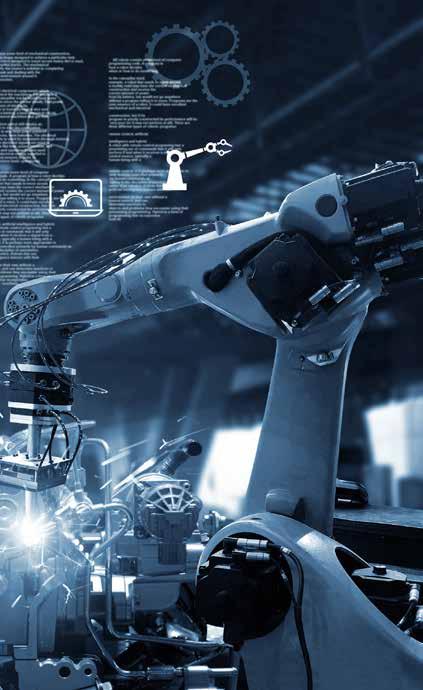
7 minute read
RISE OF THE BOTS
RISE OF THE BOTS RPA OFFERS QUICK AND EASY WAY TO PRODUCTIVITY FOR ORGANISATIONS EMBRACING DIGITAL TRANSFORMATION IN THIS AGE OF THE PANDEMIC. HERE IS WHAT YOU NEED TO KNOW ABOUT BUSINESS PROCESS AUTOMATION TECHNOLOGY.
Covid-19 has accelerated the pace of digital transformation initiatives in the region as companies respond to unprecedented changes in business models and customer behaviour. Automation has reached an inflection point in the wake of the pandemic, and one of the technologies considered as a key component of digital transformation is robotic process automation (RPA).
Advertisement
The rapid shift to the remote work model has made automation of business processes an imperative, and some predict the RPA market will reach $25 billion by 2025. Apart from pure-play vendors such as UiPath, Automation Anywhere, and Blue Prism, lately, many tech behemoths, including Microsoft and IBM, have ventured into the booming RPA market.
“We believe that the RPA is a key component of the Digital Transformation program within institutions. It provides a bridge between legacy applications to digital channels while allowing the automation of the last mile. By learning to perform repetitive tasks, ranging from simple clicks and copy-paste activities to more complex tasks and workflows such as document understanding or invoicing, network management, customer/
employee support desk etc, software robots support orsanisations to tackle large amounts of activities,” comments Karan Dixit, Regional Vice President Middle East & Africa for UiPath.
Across industries including legal, finance, insurance, transport, and more, RPA automates high volume, timeconsuming tasks either automating them completely or being a digital assistant to employees greatly improving their speed, accuracy and satisfaction. By being able to relegate those to software robots, the organisation can shift the focus on the front office and enable employees to focus on high-value tasks such as marketing or customer support, thus boosting the level of responsiveness at multiple touchpoints across the value chain, he continues.
Seif Alhawatmah, RPA Director, TSME, concurs and says RPA plays an extremely vital role in today’s digital transformation technology toolset. “The rapidly growing adoption of RPA, an extremely user-friendly business tool, enables businesses to automate their processes and quickly realise benefits – in days and weeks instead of months, hence elevating efficiency and effectiveness levels. In simple words, RPA enables enterprises to apply technology that can be governed by business logic and structured inputs.”
According to Varun Goswami, Global head– New Products COE, Newgen Software, due to the COVID-19 pandemic, organisations have asked their employees to work remotely to optimise costs and have been trying to ensure continued and uninterrupted business operations. In such a scenario, robotic process automation (RPA) plays a vital role in managing repetitive and mundane tasks.
The service industry, for instance, is heavily dependent on humans. It’s time for such organisations to identify the right set of processes and automate them with bots to reduce dependency on manual and paper-based processes,

he says. ACROSS INDUSTRIES INCLUDING LEGAL, FINANCE, INSURANCE, TRANSPORT, AND MORE, RPA AUTOMATES HIGH VOLUME, TIMECONSUMING TASKS EITHER AUTOMATING THEM COMPLETELY OR BEING A DIGITAL ASSISTANT TO EMPLOYEES GREATLY IMPROVING THEIR SPEED, ACCURACY AND SATISFACTION.
Karan Dixit

Some industry pundits caution that RPA is not a silver bullet solution. “In the race to outpace digital transformation, robotic RPA is often heralded as a quick and easy way to streamline critical processes, often extending the life of legacy systems. While RPA is valuable to furthering the overall path to digital transformation, it is best used as a short-term fix. To eliminate tactical band-aids and costly disruption, organisations need to focus on a longterm intelligent automation strategy,” notes Anas. Abdul-Haiy, Director and Deputy CEO of Proven Consult.
How to avoid RPA pitfalls
Statistics suggest that around 30-50% of RPA projects fail, and organisations struggle to realise the desired results.
“RPA is well-known for its ease of adoption. However, that doesn’t mean that deploying automation software doesn’t come with challenges. Firstly, due to the relative ease of implementation, companies can decide to implement RPA without clarifying at a cross-organisational level how their automation goals fit within the larger company strategy. A successful PoC should not be viewed as a recipe for a successful RPA implementation strategy,” says Dixit.
According to UiPath, one of the possible pitfalls is failing to enable a close business-IT collaboration. Typically, a company’s business operations team brings to the table
Anas A. Abdul-Haiy

Manish Ranjan

a complete macro perspective on its long-term goals and the strategy to accomplish them. The IT department, in its turn, provides advance technical knowledge of how the existing IT infrastructure operates, starting with testing and maintenance and including data security oversight as well as overall software deployment support. That is why, a successful RPA implementation must rely on a close collaboration between business and IT, which must both ensure long-term governance for the deployment.
Alhawatmah from TSME warns that unlike other technologies, not all processes are fit to be implemented on RPA. RPA is a tool that basically mimics human actions. Hence it is vital to identify processes that can be automated through RPA as some of WITH RPA, BUSINESSES CAN AUTOMATE THE MUNDANE TASKS, AI/ML BRING INTELLIGENCE TO THE TASKS, AND, A BPM PLATFORM EXECUTES THE PROCESS END-TOEND IN REAL-TIME WITH STRAIGHT-THROUGH PROCESSING, WITH THE FLEXIBILITY TO INTERVENE OR ROUTE IT FOR EXCEPTIONS, IF ANY.
these processes will continue to require the human element. Identifying the right processes from stage one will result in effective implementations and will avoid failed attempts.
Manish Ranjan, Program ManagerSoftware & Cloud, IDC MEA Region, advices organisations to build a comprehensive and scalable automation plan, which is linked with the wider digital transformation and other strategic initiatives. Organisations planning to leverage RPA needs to identify the repetitive, mundane, and time-consuming processes which are likely to benefit from the automation. “Once these use cases are identified that minimise productivity and strain workforce, organisations should indulge in automation process planning with appropriate technology portfolio, start with a few RPA bots in selective departments to measure the ROI and benefits, and then expand RPA deployment across multiple departments and eventually across the entire organisation.”
What’s next?
Hyperautomation is said to be the next trend in the evolution of RPA. Hyperautomation refers to an effective combination of RPA and AI functions such as Machine Learning (ML) and Natural Language Processing (NLP) to automate processes that augment humans. Gartner has named hyperautomation among the top 10 strategic trends for 2020.
“Hyperautomation connects applications, understands data, can make decisions based on logic, and can even help with predictions. This is set of logical processes, managed by software that goes hand in hand with humans,” says Abdul-Haiy from Proven Consult.
Goswami from Newgen says hyperautomation will help bridge the gaps in RPA implementation by enhancing RPA capability along with intelligence. With RPA, businesses can automate the mundane tasks, AI/ML bring intelligence to the tasks, and, a BPM platform executes the process end-to-end in real-time with straightthrough processing, with the flexibility to intervene or route it for exceptions, if any. It also triggers RPA bots for realtime execution of traditionally manual routine steps.
Ranjan from IDC points out that most of the key vendors within the RPA market like UiPath, Automation Anywhere and BluePrism, have integrated AI within their RPA solutions. As deployments of AI and cognitive solutions based on machine learning increase, demand for intelligent solutions capable of selflearning and self-healing will rise from organisations looking to enable true digital transformation.
“Hyperautomation brings together several components of process automation, and integrates technologies and tools that amplify the ability to automate work. Artificial intelligence (AI) is one of them. Thanks to additional capabilities, such as machine learning (ML), natural language processing (NLP), intelligent optical character recognition (OCR), and AI computer vision, software robots can see and read texts like a human would,” sums up Dixit.
NOMINATE NOW!
SAUDI ARABIA EGYPT 14 SEPTEMBER 2020
The Middle East is a bubbling cauldron of innovation. The pace of digital transformation in the region is accelerating in the wake of the pandemic with the rapid adoption of digital technologies such as AI, blockchain, and cloud computing. ICT Leaderships Awards 2020, to be held on 14th September, will recognize companies in Saudi Arabia and Egypt whose practice of ICT has led to substantial benefits and weathered business disruption during lockdown.
Chosen by CXO Insight Middle East editors, we are going to turn the spotlight on organisations that are making smart business decisions with emerging technologies. Nominate yourself today to be part of this awards programme that celebrates business and technology excellence.










